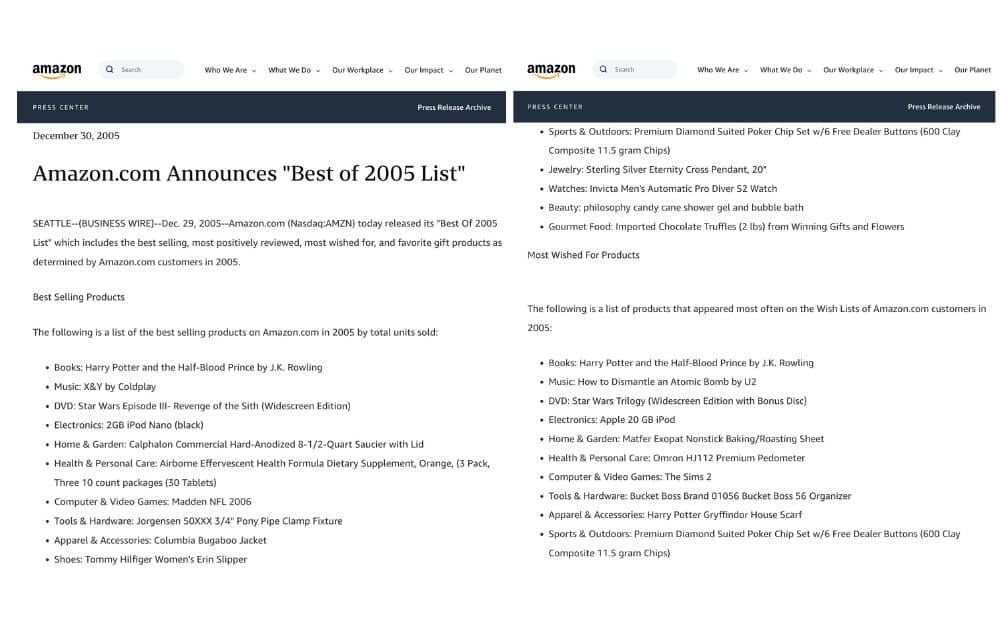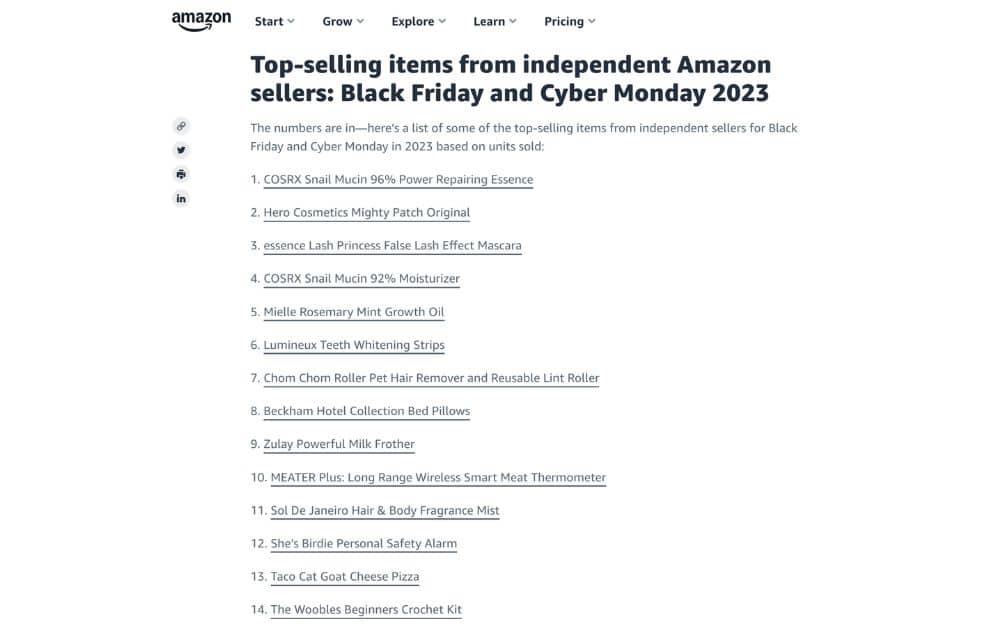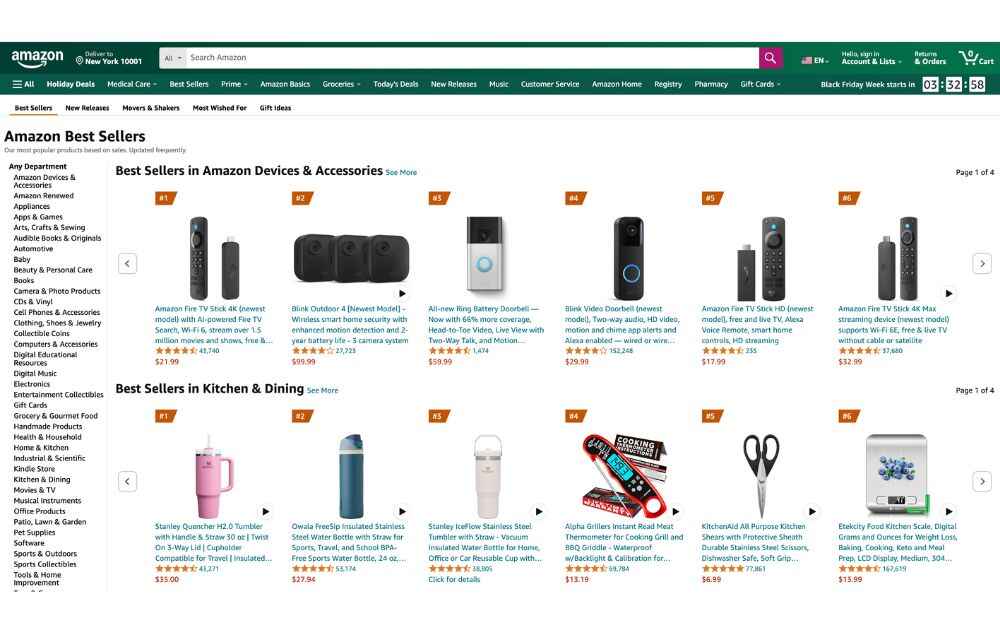Keeping up with Amazon trends is crucial for sellers who want to stay ahead.
Ecommerce is ever-evolving, and you need to keep in step with consumers to stay relevant and profitable.
For instance, would you invest a majority of your capital in fidget spinners, VR headsets, and portable DVD players today? Most probably not.
Though these items sold well online in the past, they aren’t getting many sales anymore because of shifts in technology and consumer preferences.
Below we’ll dive deep into Amazon trends, including its types and how you can stay updated. We’ll also discuss practical strategies to help you capitalize on these trends.
What Are Amazon Trends and Why Do They Matter?
Amazon trends refer to the patterns and shifts shaping how sellers can succeed on the platform. These patterns and shifts apply to factors like:
- Consumer behavior
- Product demand
- Marketplace activity
These trends encompass various aspects of selling, such as popular product categories, seasonal sales patterns, and competitive pricing strategies.
When sellers ask, “Which type of product sells the most on Amazon?” The answer isn’t static, as product demands can change depending on seasons, consumer needs, and global events.
For instance, here’s a 2005 Amazon press release about their best-selling products 20 years ago:
Now let’s compare the products on that list to the list of Amazon top-selling items during Black Friday and Cyber Monday 2023:
Looking at these lists alone, it goes without saying that you can’t get stuck at a specific time if you want to thrive on Amazon. You need to keep up with trends to stay relevant, adapt quickly, and make decisions based on solid data.
Key Types of Amazon Trends
Let’s break down the key types of Amazon trends every seller should follow:
Amazon Search Trends
Understanding Amazon search trends allows sellers to identify popular keywords and phrases that shoppers use to find products. These insights help optimize product titles, descriptions, and backend keywords, making it easier for customers to discover your listings.
- Example. Searches for “eco-friendly kitchen tools” spike during Earth Day promotions.
Amazon Price Trends
Price plays a crucial role in a customer’s buying decision. Monitoring Amazon price trends helps sellers adjust their pricing dynamically to stay competitive without sacrificing profit margins.
- Example. Prices for fitness equipment fluctuate significantly between January (New Year’s resolutions) and summer.
Amazon Sales Trends
Tracking Amazon sales trends reveals when products experience seasonal or event-driven spikes in demand. Sellers can use this information to plan inventory and promotional campaigns.
One important tip to stay updated of this trend is to check the Amazon BSR list regularly to identify top-performing products.
- Example. Black Friday and Cyber Monday sales trends show high demand for tech gadgets and home appliances.
Amazon Product Trends
Product trends, meanwhile, delve into which products or categories are becoming popular. These trends reveal what items are gaining traction over time, often due to changes in consumer preferences, emerging needs, or market innovations.
- Example. A growing demand for eco-friendly products like reusable water bottles or biodegradable packaging.
Amazon Selling Trends
These Amazon trends focus on how sellers operate within the platform, including marketing strategies, inventory management, and fulfillment options.
In addition to keeping up with Amazon’s policy changes, it’s crucial to explore the marketplace’s internal and external tools to streamline operations.
- Example. More sellers are adopting FBA (Fulfillment by Amazon) for faster delivery and better customer satisfaction.
Amazon Shopping Trends
Understanding Amazon shopping trends means identifying how consumers behave on the platform. Whether it’s the shift toward mobile shopping or increased demand for sustainable packaging, these insights help sellers align with customer expectations.
- Example. Mobile shopping now accounts for a significant portion of Amazon’s traffic, making mobile-optimized listings essential.
How to Stay Updated on Amazon Trends
Here’s another crucial question among sellers: How do I find Amazon search trends? There are several ways to stay updated on Amazon trends, and here are a few:
Use Amazon’s Own Tools
Amazon provides several in-platform resources to help sellers stay on top of trends. One of the first tools you can explore is right within the marketplace – the Best Sellers page, which showcases the top-selling products across various categories and is updated hourly.

Another tool you can utilize is Amazon Insights, which is a market research program that offers sellers deeper insights into consumer preferences and behavior. You can also make the most out of Amazon Seller Forums, where you can learn from other sellers and discuss real-time trends.
Leverage External Resources
External tools and resources can also provide a deeper dive into data and help sellers plan strategically.
Google Trends is a free tool you can use to learn more about consumer interest toward specific products or topics. Simply enter product-related terms or categories and look for spikes in search interest that may indicate a growing demand for certain products.
For instance, searches for the term Ashwagandha have increased over the past five years:

You can also explore external platforms like Jungle Scout, AMZScout, or Helium 10, which help track product trends, keyword data, and pricing fluctuations.
In addition, you can reach out to Amazon consultants like AMZ Advisers, who can help you navigate Amazon trends and offer other services like FBA coaching, and marketing and inventory optimization.
Monitor Competitors
Understanding how competitors adapt to Amazon trends can reveal valuable opportunities. To conduct a competitor analysis, check out your competitors on Amazon and see what’s working for them by reviewing their:
- Product listings
- Pricing strategies
- Customer reviews
Follow Consumer Behavior Reports
Tracking broader consumer trends can help you stay aligned with Amazon trends and shopper expectations in general. Monitor demand for features like sustainability, faster shipping, or specific product categories.
Here are a few platforms where you can access reports and studies:
- McKinsey & Company. Provides in-depth analyses of consumer behavior and retail trends.
- Statista. Offers a wide range of statistics and reports on shopping behavior and consumer spending.
- IBM Institute for Business Value. Publishes studies on consumer expectations, including sustainability and shopping preferences.
You can also subscribe to industry blogs and newsletters to get regular updates on Amazon trends and retail shifts.
Practical Strategies to Act on Amazon Trends
Following Amazon trends is only the first step. You must know how to act on these insights to turn this data into tangible results.
Here are a few practical strategies to use trends to grow your ecommerce business:
Optimize Product Listings
To align with Amazon search trends, ensure your product listings are optimized for visibility and conversions. That said, it’s crucial that all parts of your listings are geared toward addressing your audience’s needs. Remember to:
- Incorporate trending keywords into titles and descriptions to match what shoppers are looking for.
- Use high-quality images that highlight the features of the product that are most important to consumers.
- Actionable tip. If the key term “sustainable kitchen gadgets” is trending, emphasize eco-friendly materials in your product descriptions and use lifestyle images to showcase them.
Plan Inventory Around Trends
Understanding Amazon sales trends can help you manage inventory more effectively and avoid missed opportunities.
To avoid stockouts, keep inventory levels high during peak seasons or sales events like Prime Day and Black Friday.
You can also analyze past sales data to predict future demand for trending products. Additionally, you can use Amazon’s FBA Inventory Planner or external tools to avoid overstocking or understocking.
- Actionable tip. If fitness equipment spikes in January, ensure your inventory is ready before the New Year begins.
Adjust Pricing Dynamically
Shoppers often compare prices across multiple listings, and even a slight price difference can influence their choice. By dynamically adjusting prices, sellers can stay competitive and maximize profits without losing customers to better-priced competitors.
One way to leverage Amazon trends in pricing is to use automated repricing tools to match market trends without sacrificing profitability.
Here are a few ways you can adjust your pricing to increase sales:
- Sale Periods. During Black Friday or Cyber Monday, you might lower prices slightly to undercut competitors. This temporary adjustment can increase sales volume.
- Seasonal Demand. For high-demand products like heaters in winter, slightly raising prices when competitors are out of stock can maximize profits while still offering value to shoppers.
- Slow-Moving Inventory. When products aren’t selling as expected, reducing prices dynamically can attract buyers and clear inventory.
Focus on Customer Experience
Amazon shopping trends influence buyers’ experience, including expectations like faster delivery, seamless checkout, and an increasing preference for sustainability. Adapting to these shifting expectations is vital to maintaining customer satisfaction and earning repeat business.
Here are a few ways you can boost customer experience:
- Prioritize fast delivery options, as options like one-day Prime shipping are popular, especially during the holidays.
- Respond promptly to negative reviews and offer replacements. By doing so, you can turn dissatisfied customers into loyal buyers.
Other Amazon Trends
Regarding Amazon trends, products and categories aren’t the only factors to consider. Here are the most vital Amazon selling trends to remember.
How-To Content
Gone are the days of writing promotional content. The modern consumer wants informative content to make the best purchasing decision. Help your buyers along the journey by offering the information they need.
Many types of content can help consumers, though how-to content will be one of the biggest Amazon trends in 2024.
Your how-to content can include tutorials, whitepapers, templates, ebooks, or worksheets. This content is educational and will help your consumers better use your products.
AI
AI in ecommerce is projected to reach $16.8 billion by 2030, and brands should start implementing this technology now.
There are many ways that eCommerce stores can use AI, such as by writing product descriptions and implementing chatbots. If customers opt-in for data collection and email newsletters, you can send them personalized product recommendations.
AI can also complete menial tasks quicker. This includes inventory management, fraud detection, and price optimization.
AR and VR
Augmented reality (AR) and virtual reality (VR) are becoming regular parts of the shopping experience. AR is especially popular now; by 2025, one-third of American consumers will have used AR in e-commerce.
The best examples of AR in eCommerce include picturing what a furniture item would look like in your home or what an outfit would look like before trying it on.
Social Media Shopping
Social buyers in the US now make up 32% of the consumer population. TikTok, Instagram, and Facebook have expanded their platforms to allow customers to shop while browsing social media.
So, this is the perfect time to add social media shopping to your strategy.
Follow the Latest Amazon Trends
By staying updated on Amazon trends, you empower your brand to be flexible enough to adjust to shifting consumer demands and buying habits.
Success on Amazon isn’t about luck—it’s about staying informed, being proactive, and continually adapting to the ever-changing marketplace.
Are you struggling to keep up with Amazon trends and product research? We can help you unlock your full potential on Amazon.




